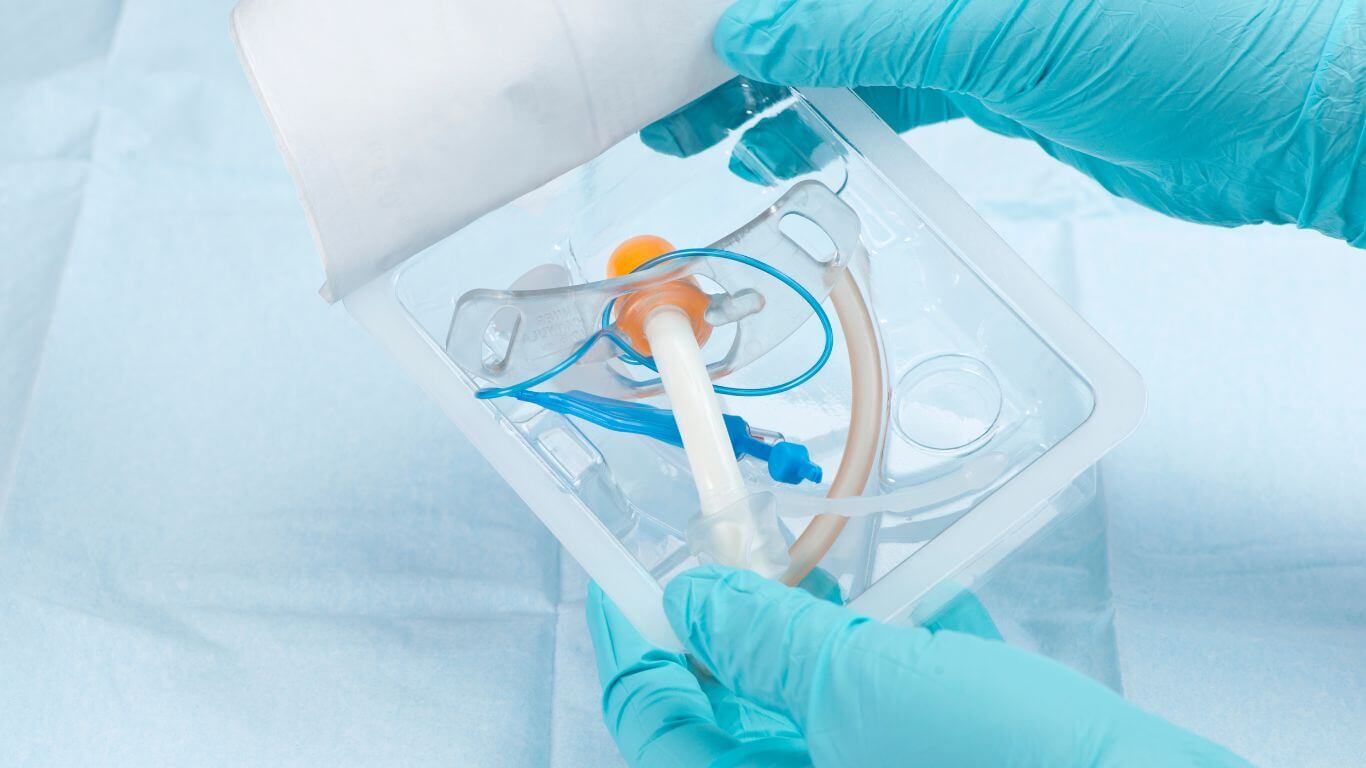Your cart is currently empty!
Phthalates are widely used as plasticizers in the manufacture of plastics, particularly polyvinyl chloride (PVC), a material commonly used in medical devices. Some phthalates are classified as reproductive toxicants and/or endocrine disruptors. In a medical device, the use of carcinogenic, mutagenic, or reproductive toxic (CMR) substances, as well as those with endocrine-disrupting properties, must be given special attention by the manufacturer.
What Types of Phthalates for What Uses
The phthalate family mainly provides plastics with properties associated with increased flexibility and suppleness. The addition of plasticizers can go up to 50% weight per weight (w/w) of the PVC material. The formulation of the plastic material can be composed of either a single plasticizer or a mixture of different plasticizers, together contributing to the desired performance.[1]
PVC is used in medical devices such as infusion sets, extracorporeal circulation circuits, dialysis lines, respiratory circuits, feeding tubes, catheters (suction, bladder, endotracheal, etc.), blood bags, and medical gloves.[1],[2]
Phthalates are obtained by esterification of phthalic acid with one or more alcohols. The position of the carboxyl groups on the benzene ring differentiates ortho-phthalates (esters of 1,2-benzenedicarboxylic acid) from meta- and para-phthalates (esters of 1,3- and 1,4-benzenedicarboxylic acid, respectively). Depending on the length of their carbon chain, phthalates are classified as low molecular weight with 3 to 6 carbon atoms in their side chain or high molecular weight with 7 to 13 carbon atoms in the side chain.[2]
Low molecular weight and high molecular weight phthalates represent 80% of phthalate consumption in Europe. The most commonly used are:[2]
- Low molecular weight phthalates:
- Diisobutyl phthalate (DIBP) – CAS Number 84-69-5
- Dibutyl phthalate (DBP) – CAS Number 84-74-2
- Benzyl butyl phthalate (BBP) – CAS Number 85-68-7
- Di(2-ethylhexyl)phthalate (DEHP) – CAS Number 117-81-7
- High molecular weight phthalates:
- Diisodecyl phthalate (DIDP) – CAS Number 89-16-7
- Diisononyl phthalate (DINP) – CAS Number 28553-12-0
- Di(2-propylheptyl) phthalate (DPHP) – CAS Number 53306-54-0
- Ditridecyl phthalate (DTP) – CAS Number 119-06-2
DEHP has been the most commonly used ester phthalate plasticizer in medical devices for many years. DEHP also has a stabilizing effect on red blood cells in blood bags, reducing hemolysis during storage and improving transfusion efficiency.
Issues Related to Phthalates: Toxicity and Exposure
Toxicity
The toxicity of DEHP and presumed danger to human health are well documented. DEHP has been classified as a category 1B reproductive toxicant (i.e., Hazard statement H360FD: may damage fertility – suspected of damaging the fetus) according to European Regulation No. 1272/2008 of 16/12/2008 (known as the “CLP” Regulation) on the classification, labeling, and packaging of substances and mixtures. Several other phthalates, such as BBP, DBP, DIBP, as well as dicyclohexyl phthalate (DCHP, CAS Number 84-61-7), di-iso-decyl phthalate (DIPP, CAS Number 605-50-5), and Di(2-methoxyethyl)phthalate (DMEP, CAS Number 117-82-8), have the same classification (reproductive toxicant 1B). Additionally, having a chemical structure similar to that of steroid hormones naturally present in the human body, some phthalates are suspected of acting as “endocrine disruptors” by interacting with endogenous receptors.[2] Thus, DEHP, BBP, DBP, DCHP, and DIBP are listed as substances of very high concern (SVHC) according to European Regulation REACH No. 1907/2006 for their suspected reproductive toxic and endocrine-disrupting properties for human health. The authorization procedure for SVHC aims to ensure that these substances are gradually replaced by other substances or less hazardous technologies as soon as economically and technically viable alternatives are available.
Exposure
To confer a flexible structure to PVC, there is no covalent bond between the plasticizer (phthalate) and the matrix. The phthalate can therefore easily migrate out of the PVC structure into solutions or substances in contact with the PVC. DEHP is the plasticizer with the highest migration potential, while lower migration has been measured for DINCH (8 times lower), Di(2-ethylhexyl) terephthalate [DEHT] (18 times lower), and Tri-n-octyl trimellitate [TOTM] (more than 100 times lower than DEHP). Due to the hydrophobic nature of plasticizers, this migration is favored in contact with lipophilic substances. The migration of each plasticizer will therefore vary depending on the nature of the contacting fluids (hydrophilic, lipophilic), the composition of the PVC (notably the presence of other additives), and the environmental context (contact duration, temperature, flow rate).[1],[2]
For the general population, although exposure to plasticizers, mainly DEHP, remains diverse, food (via plastic packaging) is the main source of exposure. Specific migration limits for plastic materials and objects in contact with food have therefore been set by the European Commission.[1],[2]
In the medical field, patients can be exposed to phthalates by ingestion, inhalation, dermal absorption, and other parenteral routes.[2] Patients undergoing hemodialysis, and/or extracorporeal membrane oxygenation (ECMO), as well as premature infants in neonatal intensive care units, have been identified as high-risk groups for phthalate exposure.[1]
When phthalates enter the human body, their half-life varies from a few hours to several days before being excreted in urine, sweat, or feces. The metabolism of phthalates generally involves two steps: hydrolysis and oxidation, which will lead to the formation of hydrolytic monoesters, and a conjugation step aimed at producing hydrophilic glucuronide conjugates, which are more easily excretable. Adults excrete phthalates conjugated to glucuronic acid via urine, but the conjugation pathway in infants is immature, particularly in preterm infants, and their glomerular filtration rate is low.[2]
The exposure of premature newborns in intensive care units is therefore particularly concerning, considering that these newborns are in constant contact with feeding tubes, endotracheal tubes, and/or umbilical catheters. It has also been observed that phthalate concentrations in urine were significantly higher in newborns in neonatal units than in full-term infants.[2]
Regulatory Restrictions
Particular attention is paid to substances known as “CMR” (Carcinogenic, Mutagenic, or Reproductive toxic) and endocrine disruptors. To limit the use of hazardous substances in medical devices, Regulation (EU) 2017/745 of the European Parliament and of the Council of 5 April 2017 on medical devices requires that devices or parts of devices or materials used do not contain carcinogenic, mutagenic, or reproductive toxic substances of category 1A or 1B (according to Regulation (EC) No. 1272/2008), or endocrine disruptors, in a concentration greater than 0.1% by mass fraction (w/w) (requirement 10.4.1). If applicable, the presence of such substances at a concentration > 0.1% (w/w) must be justified by the manufacturer (requirement 10.4.2), and labels indicating the presence of these substances must be affixed to the device and/or packaging (requirement 10.4.3). These requirements aim to encourage the substitution of these substances as much as possible for human health. Their use must be justified by a thorough analysis of the risks and benefits of patient/user exposure, including discussing other materials or alternative designs. The impact of these alternatives on the functionality and performance of the medical device is also part of this evaluation. The guidance published by SHEER in 2019, and recently updated in June 2024, outlines the different steps to follow for the benefit-risk assessment related to the presence of CMR or endocrine-disrupting phthalates in certain medical devices.[1]
The most commonly used alternatives to CMR phthalates are as follows:[1],[2]
- Tri-n-octyl trimellitate (TOTM) – CAS Number 89-04-3
- Diisononyl hexahydrophthalate (DINCH) – CAS Number 166412-78-8
- Di(2-ethylhexyl) terephthalate (DEHT) – CAS Number 6422-86-2
- Diisononyl phthalate (DINP) – CAS Number 28553-12-0
- Di(2-ethylhexyl) adipate (DEHA) – CAS Number 103-23-1
- Acetyl tributyl citrate (ATBC) – CAS Number 77-90-7
- n-1 butyryl-tri-n-hexyl citrate (BTHC) – CAS Number 82469-79-2
However, some alternatives may cause reproductive toxicity by analogy with DEHP. So far, these alternative substances require higher doses to induce reproductive toxicity, indicating a potentially lower risk of inducing such results.[1] Nevertheless, toxicological information is less exhaustive for alternative plasticizers, limiting the risk assessment of these substitutes.
What Manufacturers Should Remember
The analysis of materials and manufacturing processes of the device is a crucial first step in evaluating the residual risks of a device. Extractable studies and chemical analysis following ISO 10993-18, coupled with a toxicological analysis of extractables according to ISO 10993-17, can provide elements to minimize the need for biological tests involving animals and allow for quantitative measurement of toxicological risks related to such substances. When exposure to the substance from the device (under maximized conditions) is significantly lower than the tolerable daily intake (i.e., safety margin > 1, using a conservative approach), the risk of systemic toxicity related to this substance can be considered negligible. Conversely, when the ratio is less than 1, it generally indicates a possible or probable toxicological risk of the chemical in question. The toxicological evaluation is always adapted to the device and its clinical use.
For manufacturers, it is important to investigate the source of phthalates in the device from raw material suppliers as well as within the manufacturing steps. With DEHP being classified as a reproductive toxicant 1B, if the concentration is > 0.1% (w/w), the manufacturer must justify the presence of this CMR substance, in accordance with GSPR 10.4.2. If applicable, DEHP must be substituted. Based on experience at NAMSA, DEHP has been found in the extractables of devices claimed to be DEHP-free.
If the European regulation on medical devices allows the use of phthalates with potentially CMR 1A/1B properties or endocrine-disrupting properties in medical devices at concentrations above 0.1% (w/w), this is only allowed when it can be justified by a thorough analysis of the risks and benefits, including exploring other alternatives. While it is advisable to minimize exposure to phthalates, it is important to keep in mind that many interventions involving phthalate exposure also save lives and remain necessary in the absence or development of less concerning alternatives for their negative effects on human health.
Frequently Asked Questions (FAQ)
The extractables profile (ISO 10993-18) of my device has identified a phthalate compound. What should I do?
You should first determine the identification of the phthalate compound, as not all are CMR 1A or 1B substances or have endocrine-disrupting properties. If the presence of this phthalate compound is unexpected, you will need to investigate the source of this phthalate compound via a risk analysis. This will include a review of the documents from the materials suppliers and a complete review of the manufacturing process. As a risk control measure, this could lead to a modification in the raw material selection and/or in the manufacturing line.
My device is composed of PVC tubing, and chemical characterization has identified high concentrations of DEHP. The associated toxicological risk assessment per ISO 10993-17 did not conclude that there is a negligible risk associated with this substance. What should I do next?
From a toxicity point of view, as requested in ISO 10993-18, extraction conditions are intended to exaggerate the extraction profile of a device’s clinical conditions of use. Hence, exaggerated conditions will always be selected as a first intention. When applicable, a chemical characterization mimicking the clinical conditions of use (i.e., simulated use extractions) could be explored to investigate if the release of DEHP “in real life scenarios” is acceptable from a toxicological point of view. From a regulatory point of view (EU MDR), the presence of DEHP (which is a CMR 1B substance with ED properties) at a concentration > 0.1% (w/w) will have to be justified in accordance with the GSPR 10.4.2.

